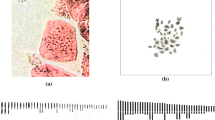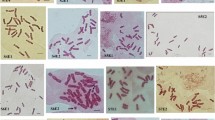Abstract
The genus Paullinia includes the economically important P. cupana, known as guaraná in Brazil and more recently in the world market. Native Americans of the Maué and Andirá tribes cultivated P. cupana ‘Sorbilis’ in central Amazon, and the Barés cultivated the ‘Typica’ variety in the upper Negro River (Brazil). Cytological studies in the Sapindaceae family have concentrated on the diversity in number (from 2n = 14 to 96) and size of the chromosomes. In Paullinia, seven species have been karyotyped and all show 2n = 24. Meristem maceration, cellular dissociation and air-drying techniques were used for cytogenetic preparations and DNA content was determined by flow cytometry. Chromosome characterization and DNA content of Paullinia cupana Kunth ‘Sorbilis’ (Mart.) Ducke (Sapindaceae) were studied. The high chromosome number (2n = 210) fall into two cytomorphological groups: (a) a metacentric and submetacentric group showing 25 sets of three pairs of chromosomes (2–76); (b) a group containing only acrocentric showing 12 sets of two pairs of chromosomes (82–105), a homologous submetacentric pair (1) and an acrocentric pair (81). Mean nuclear DNA content of guaraná was 2C = 22.8 pg. A karyogram was set up showing a high chromosome number complement.




Similar content being viewed by others
References
Antunes E, Gordo WM, Oliveira CE, Hyslop S, Nucci G (2001) The relaxation of isolated rabbit corpus cavernosum by the herbal medicine Catuama and its constituents. Phytother Res 15:416–421
Basile A, Ferrara L, Del Pezzo M, Mele G, Sorbo S, Bassi P, Montesano D (2005) Antibacterial and antioxidant activities of ethanol extract from Paullinia cupana Mart. J Ethnopharmacol 102:32–36
Boozer CN, Nasser JA, Heymsfield SB, Wang V, Chen G, Solomon JL (2001) An herbal supplement containing Ma Huang-Guaraná for weight loss: a randomized, double-blind trial. Int J Obes 25:316–324
Campos AR, Barros AIS, Santos FA, Rao VSN (2003) Guarana (Paullinia cupana Mart.) offers protection against gastric lesions induced by ethanol and indomethacin in rats. Phytother Res 17:1199–1202
Carvalho CR, Saraiva LS (1997) High-resolution HKG-banding in maize mitotic chromosomes. J Plant Res 110:417–420
Espinola EB, Dias RF, Mattei R, Carlini EA (1997) Pharmacological activity of guaraná (Paullinia cupana Mart.) in laboratory animals. J Ethnopharmaco 55:223–229
Feldman M, Levy AA (2005) Allopoliploidy—a shaping force in the evolution of wheat genomes. Cytogenet Genome Res 109:250–258
Ferrucci MS (1981) Recuentos cromosómicos en Sapindáceas. Bonplandia 5:73–81
Ferrucci MS (1989) Cromosomas en Cardiospermum y Diplokeleba (Sapindaceae), significado taxonômico y evolutivo. Bonplandia 6:151–164
Ferrucci MS (2000) Cytotaxonomy of Sapindaceae with special reference to the tribe Paullinieae. Genet Mol Biol 23:941–946
Ferrucci MS, Solís Neffa VG (1997) Citotaxonomía de Sapindaceae sudamericanas. Bol Soc Argent Bot 33:77–83
Guerra MS (1986a) Reviewing the chromosome nomenclature of Levan et al. Rev Bras Genet 9:741–743
Guerra MS (1986b) Citogenética de Angiospermas coletadas em Pernambuco. I. Rev Bras Genet 9:21–40
Hancock JF (2005) Contributions of domesticated plant studies to our understanding of plant evolution. Ann Bot 96:953–963
Henman AR (1982) Guaraná (Paullinia cupana ‘Sorbilis’): ecological and social perspectives on an economic plant of the central Amazon basin. J Ethnopharmacol 6:311–338
Jones K (1998) Robertsonian fusion and centric fission in karyotype evolution in higher plants. The Bot Rev 64:273–289
Judd WS, Campbell CS, Kellogg EA, Stevens PF (2002) Plant systematics, a phylogenetic approach. Sinauer Associates, Sunderland
Levan A, Fredga A, Sanderberg AA (1964) Nomenclature for centromeric position in chromosome. Hereditas 52:201–220
Levin DA (2002) The role of chromosomal change in plant evolution. Oxford University Press, New York
Lleras E (1992) Espécies de Paullinia com potencial econômico. In: Bermejo H, León JE (eds) Cultivos Marginados: Otra Perspectiva de 1492. Food and agriculture organization (FAO) and Jardín Botánico de Córdoba. FAO Plant Prod Prot Pap (Roma) 26:221–226
Mangenot S, Mangenot G (1958) Deuxième liste de nombres chromosomiques nouveaux chez diverses Dicotylédones et Monocotylédones d’Afrique occidentale. B Jardin Bot l’état 28:315–329
Otto F (1990) High-resolution DNA flow cytometry in malignant melanoma. Cytometry Suppl 4:55
Pereira N (1974) Panorama da alimentação indígena: Comidas, bebidas and tóxicos na Amazônia brasileira, Editora São José, Rio de Janeiro
Pikaard CS (1999) Nucleolar dominance and silencing of transcription. Trends Plant Sci 4:478–483
Radkofer L (1895) Monographie der Sapindaceen-Gattung Paullini. Verlagder Konigliche Akademie, München
Radlkofer L (1931–1934) Sapindaceae. In: Engler A (ed) (1965) Das Pflanzenreich (IV). Verlag von HR Engelmann/J Cramer, Weinheim 165:1–1539
Rasband W (1997) Image SXM 1.61. A public domain software for image analysis, written at the US National Institute of Health, extensions by Steve Barrett and available from the Internet by anonymous ftp from http://www.zippy.nimh.nih.gov
Saxena PK, King J (1989) Isolation of nuclei and their transplantation into plant protoplast. In: Bajaj YPS (ed) Biotechnology in agriculture and forestry. Plant protoplast and genetic engineering. Springer, Heidelberg, pp 328–342
Semple JC (1974) Chromosome numbers of phanerogams. Ann Mo Bot Gard 61:902–903
Solis Neffa VG, Ferrucci MS (1998) Cariótipos de Sapindaceae sudamericanas. Bol Soc Argent Bot 33:185–190
Sombra LL, Gomez MR, Olsina R, Martýnez LD, Silva MF (2005) Comparative study between capillary electrophoresis and high performance liquid chromatography in “guarana” based phytopharmaceuticals. J Pharmaceut Biomed 36:989–994
Acknowledgments
We thank Prof. Charles R. Clement, Instituto Nacional de Pesquisas da Amazônia, for his critical and constructive suggestions on the article. This research is part of the REALGENE work supported by MCT/CNPq Brazil.
Author information
Authors and Affiliations
Corresponding author
Rights and permissions
About this article
Cite this article
de Freitas, D.V., Carvalho, C.R., Filho, F.J.d.N. et al. Karyotype with 210 chromosomes in guaraná (Paullinia cupana ‘Sorbilis’). J Plant Res 120, 399–404 (2007). https://doi.org/10.1007/s10265-007-0073-4
Received:
Accepted:
Published:
Issue Date:
DOI: https://doi.org/10.1007/s10265-007-0073-4




